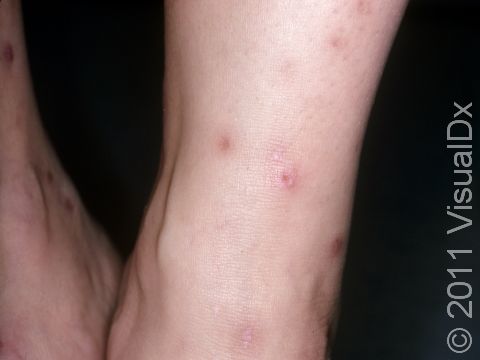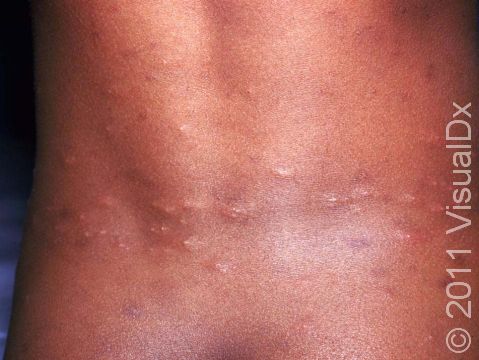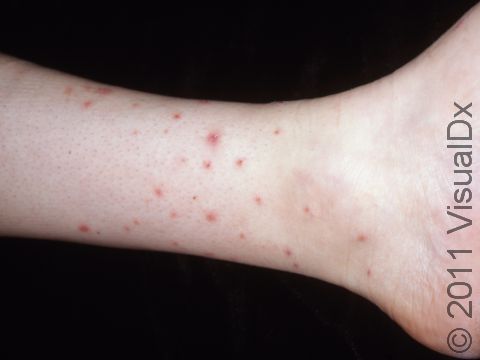Flea Bite
Fleas are bloodsucking insects that live on pets, livestock, and humans. They are small, 1–4 mm (1/16 to 1/8 in.) in length, and blackish-brown. Although wingless, fleas are capable of taking giant leaps, jumping to a height of several meters. Adult fleas feed only on blood and are capable of going long periods without feeding.
Fleas that live on humans (Pulex irritans) are relatively uncommon. The species that humans are most likely to encounter is the cat flea (Ctenocephalides felis), which also infests dogs. Humans may also encounter the dog flea (Ctenocephalides canis) or the rat flea (Xenopsylla cheopis). Cat, dog, and rat fleas do not live on people, but they will bite a human if they encounter one and are looking for a blood meal.
Fleas most often bite people around the legs and the ankles. The resulting red bump is an allergic reaction to flea saliva. The bites, which are usually but not always felt immediately, become increasingly irritated and may remain sore and/or itchy for as long as a week. Itching may be just at the site of the bites or more generalized in nature.
Who's At Risk?
Risk factors include household pets, livestock, and rodent infestation.
Some people are more sensitive to flea bites than others, and it can sometimes appear that the fleas are “picking on” one individual in a household but not others. Children aged younger than 10 are generally more sensitive than older people, as people tend to become desensitized by repeated exposure over time. Flea bites in children produce an allergic reaction in which recurrent or chronic small red bumps occur on the exposed skin areas. Individuals who are hypersensitive to fleas may also develop blister reactions.
Signs & Symptoms
Flea bites are small, raised, red bumps that are firm to the touch. The redness disappears when pressure is applied. Flea bites can be extremely itchy and may show signs of bleeding. Flea bites usually occur around the ankles and lower legs. Other common locations for flea bites include the area around the waist, armpits, creases of the elbows, and behind the knees.
Flea bites produce a variety of effects, ranging from a small, temporary red bump to long-term symptoms that may last for years depending on the sensitivity of the person bitten. The area of skin affected may increase over time, or the rash may spread to a different area. Flea bites can take a very long time to heal up and can sometimes evolve into “persistent bite reactions.” Itching and swelling may occur at the sites of older bites when the person is bitten again.
Self-Care Guidelines
The primary goal of therapy is to relieve the itching, which can be achieved by the following:
- Burow’s solution compresses applied to the bites
- Calamine lotion to which 0.25% menthol may be added by the pharmacist
- 1% hydrocortisone cream may take the edge off the itch
If flea bites have occurred indoors, all sources must be treated for effective flea control. Carpets, pet bedding, and all rooms should be thoroughly vacuumed, and pets should be treated separately.
Flea control at home may be regulated by the following measures:
- Bedding should be clean and laundered regularly.
- Bedrooms should be vacuumed regularly, especially in the corners underneath the beds.
- The indoor environment can be sprayed with a chemical used for flea infestation such as methoprene.
- A professional exterminator may be needed.
- Pets should be kept clean and regularly checked by a veterinarian.
Flea control for pets includes the following:
- Oral flea medication (available for dogs but not for cats)
- Monthly topical spot-on products
- Flea collars
Treatments
Prescription-strength mid- or high-potency topical corticosteroids can alleviate the severe itch.
Antihistamines may be prescribed for the relief of the itching. Be aware that some antihistamines cause drowsiness.
- Diphenhydramine hydrochloride (Benadryl®) – 25, 50 mg tablets or capsules, 25–50 mg nightly or every 6 hours as needed
- Cetirizine hydrochloride (Zyrtec®) – 10 mg tablets, 10 mg per day
Oral antibiotics may be necessary if secondary bacterial infection develops.
Visit Urgency
Seek medical care if,
- Itch is not alleviated using over-the-counter products
- The bites become infected due to scratching
- Blisters form in reaction to flea bites
- Bites do not resolve in a few weeks
If you develop large, painful lymph nodes and swelling in the groin, armpit or neck, seek medical help, as fleas can transmit the Yersinia pestis bacterium, which causes plague. Endemic plague is seen in the southwestern US (approximately 10-20 cases reported each year in the US) and other parts of the world.
Trusted Links
References
ers for Disease Control and Prevention. Questions and Answers About Plague. http://www.cdc.gov/ncidod/dvbid/plague/qa.htm. Reviewed August 6, 2009. Accessed September 30, 2010.
Bolognia, Jean L., ed. Dermatology, 2nd ed. pp.1305-1306. New York: Mosby, 2008.
Wolff, Klaus, ed. Fitzpatrick’s Dermatology in General Medicine. 7th ed. pp.1758-1759, 2061-2062. New York: McGraw-Hill, 2008.
Last modified on October 5th, 2022 at 7:24 pm

Not sure what to look for?
Try our new Rash and Skin Condition Finder



